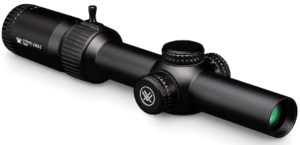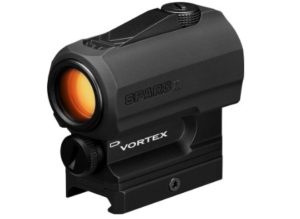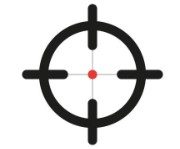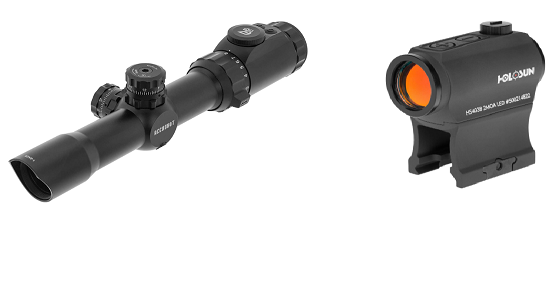Picking the right optic for your firearm is crucial to improving accuracy and precision. This is why it is important to define your requirements to make the selection process easy.
Low Power Variable Optics have a variable magnification capability. They feature complex reticles with additional information like holdover points or rangefinding features. LPVO scopes are designed for longer-range shooting, where precision and accuracy are critical.
On the other hand, red dot sights have a fixed 1x magnification. They have a simple reticle that usually consists of a single dot or crosshair. They are designed for shooting applications that require quick and easy target acquisition. This makes them ideal for close-range shooting and engaging fast-moving targets.
While LVPOs are becoming increasingly popular, red dots still have a huge audience. However, it can be hard to pick between these two options. We created this post to help you make a well-informed purchase.
In this post, we will compare and contrast LPVOs and red dots to help you make an informed purchase. We will share the pros and cons to help narrow your search for a reliable optic.
Let us get right into it.
What is an LPVO?
 LPVOs (Low Power Variable Optics) are scopes that allow for quick adjustments to the magnification, making them ideal for engaging close-range targets. You can adjust the magnification from 1x to a maximum power range of 4x, 5x, 6x, 8x, or 10x, depending on the scope you buy.
LPVOs (Low Power Variable Optics) are scopes that allow for quick adjustments to the magnification, making them ideal for engaging close-range targets. You can adjust the magnification from 1x to a maximum power range of 4x, 5x, 6x, 8x, or 10x, depending on the scope you buy.
LVPOs perform better than red dots because they allow you to adjust the magnification level to match the target’s distance. They feature coated lenses that improve image clarity. The coatings also prevent dust and grime from obstructing your view.
It is worth mentioning that LVPOs use a First Focal Plane reticle to make holdover and windage corrections across all magnification levels. This helps to eliminate any guesswork in your shooting applications.
Let us look at the pros and cons.
Pros
- They use a first focal plane reticle that allows you to make holdover and windage corrections across all magnification levels.
- The reticle is illuminated, allowing you to use it in low-lighting conditions.
- Some options have an adjustable objective lens that allows you to fine-tune the focus.
- They come with windage and elevation adjustments.
- They provide high-quality images, making it easy to acquire targets even at high magnification levels.
- They are durable and long-lasting compared to red dot sights.
- They can withstand recoil and impact.
Cons
- They do not have unlimited eye relief.
- They do not offer the best variable magnification.
- They are more expensive than red dot sights.
What is a Red Dot
 A red dot is a close-range optic with a red dot reticle that aids in fast target acquisition. This makes them suitable for fast-paced shooting applications like target shooting or home defense.
A red dot is a close-range optic with a red dot reticle that aids in fast target acquisition. This makes them suitable for fast-paced shooting applications like target shooting or home defense.
The exceptional feature of red dots is that you can adjust the brightness level of the dot. This makes it an excellent choice for hunting in low-lighting situations. In addition, you can pair it with a red dot magnifier to engage long-range targets.
The other advantage of red dots is that they are affordable and have a lightweight construction. This makes them suitable for concealed carry.
Red dots are also compatible with many firearms. They are very easy to mount and will not weigh your firearm.
The major downside of red dots is their lack of magnification. This means that it is very challenging to acquire long-range targets.
Pros
- They are compatible with a wide range of firearms.
- They are fog proof, waterproof, and shockproof.
- Red dots are ideal for shooters who wear prescription glasses.
- They help to improve target acquisition.
- The lenses are coated to improve image clarity.
- They are durable.
- They have unlimited eye relief.
Cons
- They are not suitable for acquiring long-range targets.
- They are battery dependent
- Many cheap knock-offs are available today
Frequently Asked Questions on LVPO vs Red Dot
- How does the weight of an LVPO compare to that of a red dot sight?
Most LVPOs available today are heavier and bulkier than red dot sights. This makes them challenging to carry and handle, especially when hunting or target shooting. The bulkiness or weight is important to consider if you plan to use your rifle for extended periods or in situations where weight and bulkiness are a concern.
- What is the difference between an LPVO and a Red Dot Sight?
An LPVO (Low Power Variable Optic) is a scope with a variable magnification range. The magnification is usually between 1-4x. They also feature a complex reticle with additional information like holdover points or rangefinding features. On the other hand, a red dot is an optic with a fixed magnification of 1x and a simple reticle consisting of a single dot or crosshair.
- What is the best type of optic for personal defense?
The best optic for personal defense depends on individual preferences and needs. Therefore, it is important to define your requirements to make the selection process easy. Some people prefer the quick target acquisition and ease of use of a red dot sight. Others may prefer the accuracy and precision of an LPVO.
- Is it possible to use an LPVO for close-range shooting?
Yes, you can use an LPVO for close-range shooting. However, the increased magnification and complex reticle may make it more difficult to quickly acquire the target than a red dot sight.
- Can I use a Red Dot Sight for hunting?
Yes, you can use a red dot sight for hunting, especially for close-range hunting. However, for longer-range hunting, an LPVO may be a better choice. This is because LPVOs have variable magnification, suitable for engaging targets at varying distances.
Conclusion
In this LPVO vs red dot comparison, we have looked at the major differences between these optical sights. It’s important to consider the specific features and needs before making a decision on which type of optic to choose.
LPVOs offer variable magnification and a complex reticle better suited for long-range shooting. Red dot sights have a fixed magnification of 1x, a simple reticle, and are better for close-range shooting and fast-moving targets.
We hope this post helped you learn about LVPOs and red dot sights. You can also check Red Dot Vs Green Dot.

